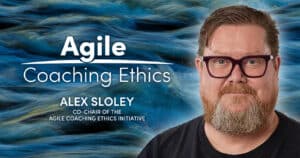This entry was written as part of the Supporting Agile Adoption program, an Agile Alliance initiative dedicated to supporting organizations and their people to become more Agile.
We have seen Agile transformation disrupted because the value that coaches provide is not transparent.
Coaches seldom make clear how their work benefits the organization. Sometimes coaches miss the “right” vocabulary, or for a leader, the value of a coach is not evident. Thus, it is helpful to make the benefit of coaches transparent. This is especially important if the organization is in a crisis. In such a situation leaders will need coaches the most. Yet, the perceived need for coaches often is the first thing to be questioned because their contribution is often unknown and unquantifiable. For example, in many organizations, when there is a struggle with budgets, the coaching role is often one of the first ones that are being questioned.
Somehow it seems hard to argue and prove the value coaches bring to the organization. Not every business intervention has a direct spreadsheet monetary growth result. We realize that in this article, we will not be able to convince core spreadsheet management thinking. Yet, we hope that we might provide some useful approach to people that have to deal with this attitude.
Being a coach is sometimes not easy. You try to help the organization grow and improve performance. You help people in various roles and work closely with different people–in teams and leadership positions. Coaches help to navigate uncertainty.
But at the end of the day, what have you really achieved? How can the success of an organization be clearly traced back to what YOU did?
Especially good coaches can easily suffer from this phenomenon, and due to their great coaching skills, they enable teams and people to come up with the solution themselves. Measuring the benefits of a coach can be a contradiction because a coach’s service is to ensure that the coachee finds the solution themselves. In this way, the coach is more of a midwife and the delivery is up to the coachee.
A potentially helpful way to approach the question is to see coaching as a business that creates value for customers. So, let’s take a look at this by creating a value proposition for coaches. To do that, a very helpful practice is the NABC value proposition scheme, which was initially invented by Curt Carlsson and his team at the Stanford Research Institute.
The scheme in essence suggests that a good value proposition consists of 4 key elements: N-A-B-C (See “The NABC’s of Value Propositions,” Curt Carlsson, Len Polizzotto, Glenn Gaudette, IEEE Engineering Management Review, Vol. 47, No. 3, Third Quarter September 2019).
- N stands for the important, unmet customer need.
- A stands for your approach to satisfy this need. Your approach needs to be unique and ideally, 2-10 times better than anything else available.
- B stands for benefit over cost. This is the total perceived benefit from your customer’s point of view–tangible as well as intangible benefits. That is put into relation to the cost: again, tangible and intangible from a customer point of view.
- C stands for competition and alternatives. Here you reflect on who or what your offering is competing with and argue how far your offering is 2-10 times better than anything else.
Need
The overall need for any organization is to address complexity. (Check out as well our article on stretching your leadership muscles). The role of a coach is to help navigate such complexity. Then the question is, “Who feels the need?”
In general, managers, teams, and all people in enterprises who are challenged by the complexity of the organization and business. Everything is entangled and so there’s little overview. Decision-making is difficult because of the uncertainties and ambiguities. Anything you do has effects and side effects, which are sometimes intended, yet often unintended or undesired.
Fundamental to the need is a willingness to innovate and improve. Along with that is required an uncertainty about how to do that combined with the belief that someone “external” can provide an important perspective. The willingness to innovate and improve is based on being unsatisfied with the current situation.
The problem is, intertwined in daily business, people get entangled in the weeds of daily business life and do not ask enough questions (as our experience shows) and therefore need an external perspective to help ask the “right” questions and gain new insights. The right questions are the ones that help everyone involved to understand better what problem they are trying to untangle. For example, often communication and/or people problems are masked with technical issues.
As Jerry Weinberg so famously stated:
“No matter how it looks at first, it’s always a people problem.” (Gerald M. Weinberg, The Secrets of Consulting)
For getting a contextual understanding of what the real problem is, people need to see the big picture. You might wonder if understanding the big picture shouldn’t be the business manager’s role. But being buried in their own work as well, while often supporting the CEO and the organization, they have neither the focus nor the time. Moreover, although managers see the need for change, at the same time they need to guarantee good business results upwards so they’re challenged by implementing a change without imposing risk. The balance of creating business results with addressing necessary change while not taking (too much) risk is a big challenge that needs to be addressed.
Approach
There is a lot of research and practice on handling complexity and change in organizations and businesses. Yet this knowledge is not widely spread or a standard part of management education. The Agile movement that emerged out of the software industry in the early 2000s has focused on learning and practically applying practices and approaches to managing complexity and change. It has become part of the education program for Agile coaches. Therefore, Agile coaches are educated and experienced in helping organizations and businesses manage complexity.
The role of a coach is to help the people in the organization to learn and practice how to navigate complexity and uncertainty. They do this by teaching, sparring, advising, coaching, and using facilitation techniques. Coaches can help navigate uncertainty by helping to probe the organization and make patterns that were previously intangible, visible, and quantifiable and by this actionable. (See e.g., Agile BOSSA nova probes)
Coaching can focus on different contexts:
- Individual: Supporting individual members of the organization to go through or lead a change. For example, helping managers in organizations to learn and use complexity management. Coaches are the ones who can help provide an overview and help leaders see the big picture because coaches move between departments. Coaches can also be the “external voice” that ensures that the topic will be heard. Sometimes they might provide the only possibility to get an external perspective. And if the coaches are external to the company, then they additionally ensure cross-pollination and learning from different companies.
- Team: Aiding teams to use (Agile) approaches to navigate uncertainty and complexity.
- Organizational and systemic: Helping management teams (and teams of teams) to use practices to achieve operational results and to evolve the organization.
To a large extent, the value of organizational coaching lies in helping managers to clarify and sharpen the vision and make it actionable throughout the organization. Coaches can support by providing a “helicopter (over)view” and insight to leaders whose main task is to create business results and enable organizations to evolve at an increased speed.
Engaging a coach requires a willingness to invest in the “soft” side of change in organizational health. Any organization or any system needs some form of “lubricant oil of organizations,” i.e. non-specific, often communicative, relationship-based, interventions that help to keep different people and factions in an organization in touch and communicating (that is to help everyone to stay in touch, to clarify matters, etc). Organization and leadership coaching provides just this.
Remember, for coaches to be successful in these different contexts, the authentic willingness and readiness to innovate and improve is essential. This requires trustful cooperation between the manager and coach. So, willingness needs to be authentic because all individuals, teams, and organizations have to be ready to change as well.
Benefit over cost
Let’s explore the benefits and the cost of working with a coach. For understanding which is which (what are the benefits and what the cost), it is essential to make both transparent.
BENEFIT:
As a manager (or as any coachee), you do not need to educate yourself in all the aspects of coaching. You can focus on the tasks you’re responsible for, e.g., business and organizational development. A coachee can benefit from a coach in many different ways, for example:
- Seeing more perspectives because the coach isn’t “buried” in a department or a business area and has experience with other teams and other departments.
- Enabling organizational health initiatives (eg by guiding or actively facilitating organizational knowledge-sharing)
- Overcoming organizational inertia
- Offering expertise and praxis in managing / leading complex change
- Acting as a sparring partner in order to help organizations and businesses adapt to changes in their environment
- Being an advisor who completes your skill profile, which will accelerate and improve the quality of your decision-making and your impact
- Translating general concepts into your specific context
- Identifying and strengthening best practices and good practices together with you on all levels: individual, team, and organizational
- Supporting you to evolve your organization by helping you drive the discovery of new good approaches that fit your organization via safe-to-fail experiments. (Probe-sense-respond; Probing: see BOSSA nova)
These benefits will materialize in different ways:
- Your leadership effectiveness will increase. You could, for example, measure this by taking regular (for seeing the change of course) self-assessment or stakeholder assessment on the Comparative Agility platform, i.e. Comparative Agile Leadership Assessment or Agile Leadership Mindset Assessment
- Your people’s motivation and job satisfaction will improve (employee surveys)
- Team effectiveness improves (employee surveys, self-assessments, and, perhaps key indicators: delivery metrics)
- Flow efficiency improves by x% due to improved workflows and collaboration across the organization
- Organizational effectiveness will improve (measured by organizational health assessments)
COST:
Engaging a coach is a serious investment in time, money, and also a willingness to change.
A coach is ALWAYS a temporary intervention/engagement. A coach’s goal is to become obsolete, as the coached person or organization has learned to evolve successfully by itself. So a permanent need for a coach is likely a sign of failure: a leader in an organization should be enabled to continue the organization’s evolution themselves, i.e. without a coach.
If the plan from the start is to always have a coach, it means the coach is not the right one for the coachee because the coachee is not enabled to change. (But also the other way around: if a coachee gets rid of a coach, it can be a sign of success or of failure because the reason to get rid of the coach might be either that the coachee has been empowered to address their challenges or that there is no willingness to change.)
There are different options for working with a coach. Very roughly, there are three main models:
- Hire an internal coach
- Engage an external coach
- A mix between the two, i.e. hire an external coach to train internal coaches
An advantage of working with external coaches is that they provide the organization with more flexibility because collaboration can be stopped at any time. This flexibility is especially important if the coach is needed for a very short term. Contrariwise, internal coaches have the advantage of understanding the company context in detail. This can mean that you find an experienced coach within your own company or you hire an experienced coach from outside. This approach is suitable if you foresee a lasting need for this kind of expertise in your organization as you foresee the need for assisting and driving evolutionary transformation as a core capability in your company by, for example, training internal coaches.
In some organizations, there is confusion between consultants and coaches. However, there is a clear distinction between the two: consultants typically focus on strategic questions while coaches typically focus on helping to implement a strategy and/or helping to solve an organizational health issue.
Competition and alternatives
Coaches are one way to meet the needs described in the Needs chapter above. What are alternatives and how are they better or worse than having a coach? It is worth exploring these alternatives, so we can further strengthen the value positioning of hiring a coach. This will help us understand how far an approach using coaches is superior to the competition and alternatives.
At first glance, the following alternatives come to mind:
- Managers
- Human Resources
- (External) business/management consultants
- Books about leadership
- Not seeking coaches
We will examine these alternatives subsequently.
Managers
Managers are expected to help their people grow, oftentimes via a coaching model. But managers do not have a 100% focus on developing people and the organization. Their prime task is to “deliver results” (whatever that might be in the given context of the organization). Also, their bandwidth on change management is limited as they have to also focus on delivering operational results. A coach is fully dedicated to helping the manager achieve organizational and operational evolution and improvement in parallel with delivering results.
Moreover, different from coaches, managers are (always) in a power position: they decide who is needed (for example, deciding whether a coach is needed or not). Also, most managers are not trained to develop their coaching skills, which can (and often will) lead to suboptimal dialogue with people reporting to them. Additionally, managers often have a huge operational responsibility, and this responsibility could be counterproductive for them if they also provide the service as a coach. For example, managers make decisions on salary and career opportunities; therefore, they do not provide the psychological safety that helps people grow for real.
All of this makes an approach via coaches superior to having an approach only via managers.
Human Resources
Human Resources (HR) is often not as embedded into an organization as a coach. An HR business partner might be part of a leadership team, but usually, people in these roles are not familiar with the subject matter of the organization. Coaches, however, often are coming from within the context of the organization and thus have a deeper understanding of the organizational system. This leads to a coach having a higher effectiveness in approaching evolution or changes.
Very often HR has people and organizational development on their agenda, but, in reality, they are too busy taking the responsibility for “just” ensuring the operational people management responsibility. HR’s key focus is on supporting management, ensuring that structure and systems are in place to enable management to handle the administrative aspect of their people management role. HR’s position in an organization often is not independent, diminishing their coaching ability to lead. HR goals often conflict with business goals and vice versa.
Also, coaches–as they are embedded in the business–are able to drive business goals and HR/people goals at the same time, something an HR Business Partner usually is not enabled to do.
(External) business/management consultants
Business consultants look at all problems from a business perspective. However, that is not always the best approach. A business consultant tends to look at the challenge through a lens of focusing on efficiency, cutting cost, value flow, cost of delay, and similar concepts. These are important topics if you are working in contexts with high predictability but not if those challenges are complex and unpredictable. However, there could be business consultants who have an Agile education and therefore are skilled to work in complex environments and are able to blur the line between consultant and coach. This means they will “dynamically” change their role from consultant to coach, applying different lenses per what is needed in a given situation.
Books about leadership: self-help
Books can help leaders to reflect and inspire them to change course. Books can provide new perspectives, for example, via interesting research, case studies, or an appealing call to action. So instead of having a coach as a mirror and/or midwife, books dealing with the challenge can fill this role. This can work particularly well if the leader has gone through similar challenges before. However, the leader needs to be ready for the message the book provides by having the “right” question. Without the right question, the book won’t tell you what you are missing in order to get the most out of it. A coach can accelerate a leader’s insight by bringing a flexible interaction style to the dialogue, enabling the relevant questions to emerge.
Not seeking Coaches
You might think you don’t need a coach to handle your transformational efforts. This might be justified when coaching is already part of your leadership DNA. So no specific role is needed anymore. However, there is a risk that the completion of the Agile transformation is only a perception.
It could be that leaders are not seeking coaches because their value has not been understood. A recommendation is to at least have a sparring session with a coach to clarify the need.
Conclusion
The NABC (Needs, Approach, Benefits over cost, Competition & Alternatives) provides a useful new perspective on the value of coaching. As a leader, you can use the insights from this article to reflect on the need for a coach. And as a coach, you can provide a better picture of the value of (your) coaching.
That said, the above NABC is quite generic. You will need to translate it to your particular context and specify it. So see it as an inspiration and use it as a base for your own (context) specific NABC.
Once you are clear about your NABC, no matter if you are an internal or external coach, or if you want to stop or to continue to work with coaches in your organization, you can use the result of the NABC to make a pitch for or argue for the value of a coach. You can even use the foundation of the NABC to get support for a particular approach or intervention.











